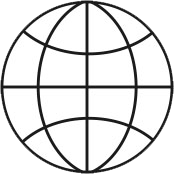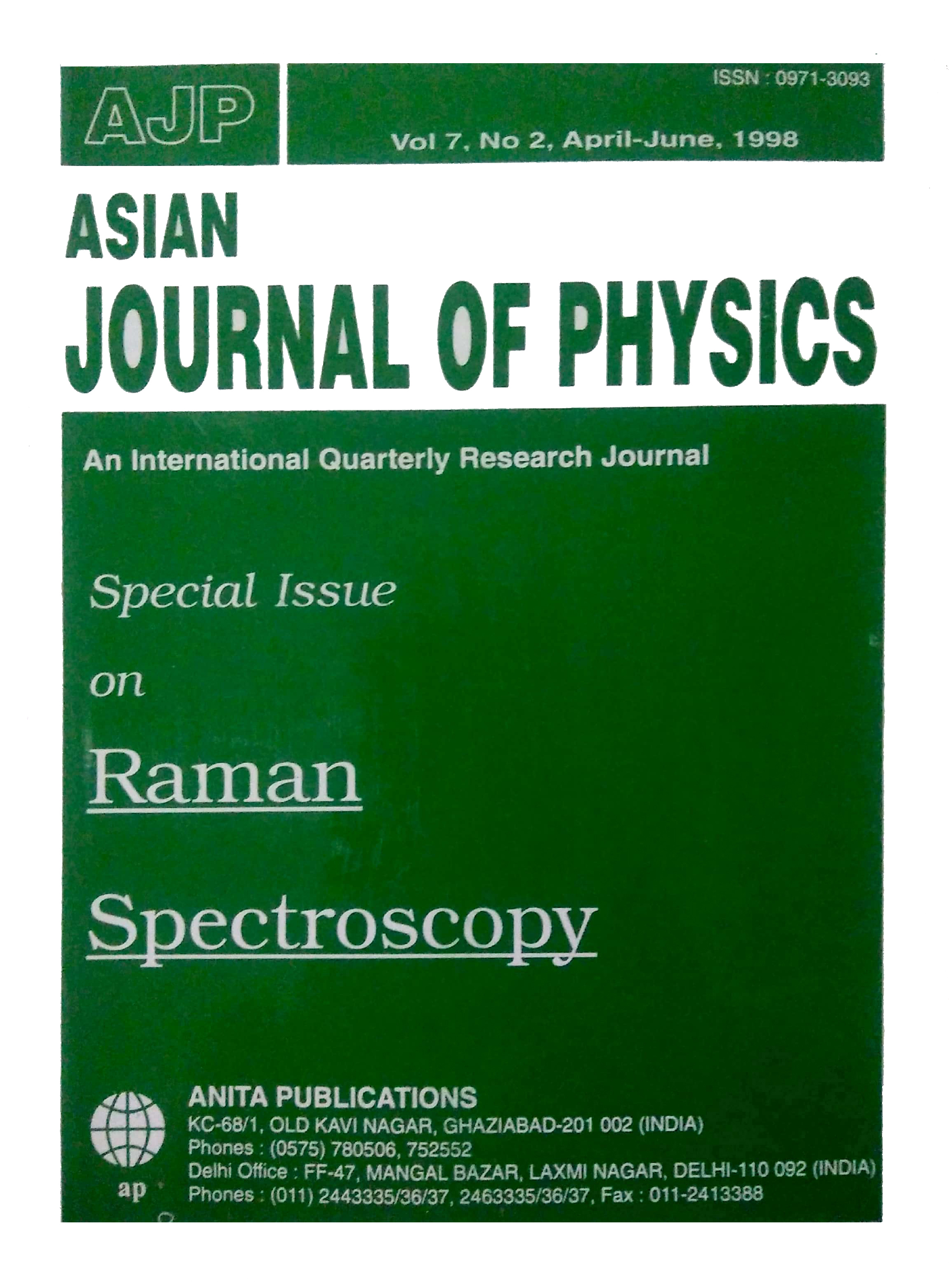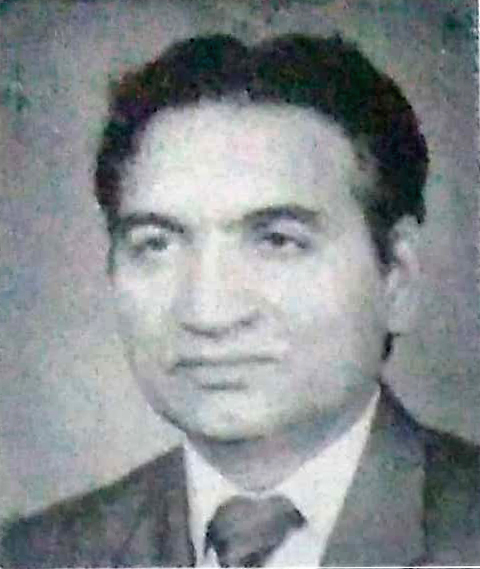
ap

ap
An International Peer Reviewed Research Journal

AJP
SSN : 0971 - 3093
Vol 7, No 2, April-June,
1998
Editorial
It is well known that Raman spectroscopy which is based on the phenomena of inelastic scattering of light is a highly specific nondestructive technique of investigating the molecular species in all phases of matter. The Raman spectroscopy is undergoing rapid developments owing to the impact of lasers, new detectors. interferometers and computers. The availability of laser light source, for excitation of Raman scattering and the developments of instrumentation have greatly stimulated interest in the use of Raman spectroscopy. Many applications have been developed during the past decade. FT-Raman spectroscopy employing NIR lasers. and its efficiency in data processing, has resulted in Raman spectroscopy becoming a tool of research as a result of which many new phenomena are being discovered and studied. Raman was aware of the potentiality of his discovery. In his Nobel lecture he said, ...the new field of spectroscopy his unrestricted scope in the problems, relating to the structure of matter. We may also hope that it will lead us to a further understanding of the nature of light and of the interactions between light and matter".

Prof V K Rastogi
Considering the immensity of significance of Raman spectroscopy as an indispensable tool for research in interdisciplinary fields encompassing almost all branches of science, we thought of devoting one of the issues of AJP to Raman spectroscopy ab initio.
We requested Prof W Kiefer, to edit this special issue on Raman spectroscopy. He accepted our request inspire of his busy schedule. however asked us to wait for some time. In the mean time, on my request. Prof G D Baruah, President Physics Section. ISCA (1998-99) invited him to deliver a general lecture at 85th Indian Science Congress, which was scheduled to be held at Hyderabad. India. during Jan 3-7. 1998. He accepted the invitation of Prof Baruah to deliver the lecture and wrote me in Sept 1997 that he will now find time to edit special issue. But nothing was certain before his visit to India in January 1998. Finally, during his visit to India he told me about the progress of the proposed special issue. We discussed many points in regard to this issue as well as on the subject and decided that AJP Vol 7. No 1 1998 would be the special issue on Raman spectroscopy.
With all my heart. I thank Prof W Kiefer for taking pain to edit this issue and I am happy to present this issue to readers.
We are grateful to all those authors who submitted their manuscripts in time. The issue is prepared directly from the manuscripts edited by Guest Editors, except in a few papers where we have made minor corrections. It is our hope that the issue will interest to readers.
V K Rastogi July 25. 1998
Guest Editorial
This is
a Special Issue of the Asian Journal of
Physics
which celebrates the seventieth anniversary of the discovery of the
"Raman Effect" by Professor Chandrasekhara Venkata Raman at the
Indian Association for the Cultivation of Science at Calcutta,
India. In the seventy years that have elapsed since the discovery
of this new scattering phenomenon of a fundamental character, the
field of Raman Spectroscopy has grown enormously and continues to
grow, encompassing a wide range of topics and applications in
physics, chemistry, biology, biochemistry, medicine, pharmacy,
environmental sciences and even in technology and
art.
Encouraged
by the editor-in-Chief of the Asian Journal
of
Physics, Professor V K Rastogi, I have sent letters to leading
scientists engaged to the Raman effect and related topics inviting
them to contribute original papers to this Special Issue. It is
indeed gratifying to note that several distinguished Raman
spectroscopists have graciously responded to my invitation inspite
of the short notice given to them. I wish to express my grateful
thanks to all the authors in particular for their cooperation in
meeting the various deadlines imposed by a Special Issue. I am very
grateful to them as well as to Professor V K Rastogi for his
encouragement and cooperation.

Prof W Kiefer
The Special Issue begins with an article, which emphasizes the most essential quality of Raman-his single-minded devotion to science as revealed by Nature. With the 21 original papers that follows, the Special Issue tries to present a glimpse of some of the recent investigations in vibrational analysis and studies of molecular structures, of biological and biophysical studies, of investigations in physics including several studies of thin films, of excited states, pigments, and surface enhanced studies. The last two papers are devoted to nonlinear Raman effects and Raman tensors.
By their contributions, the authors have helped to highlight the wide and varied spectra of activity based on the Raman effect. It is my hope that this Special Issue will be found useful by the scientific community which cherishes the ideals and memory of Professor Raman.
Wolfgang Kiefer
Institut für Physikalische Chemie
University of Würzburg Germany
Asian Journal of
Physics
Vol. 7, No. 2, (1998)
229-249
FTIR and Raman spectra of 2,4-difluorobenzonitrile
V K RASTOGI, M ALCOELA PALAFOX*, S SINGH and S K SINGHAL
Department of Physics, L.R. College, Sahibabad - 201 005, INDIA.
*Departamento de Quitnica-Fisica (Espectroscopia). Facultad de Ciencias Quimicas. Universidad Complutense. Madrid - 28040. SPAIN.
___________________________________________________________________________________________________________________________________
FTIR spectra of 2,4-ditluorobenzonitrile were recorded in KBr pellet and Nujol mull in the region 200-4000 cm-1 on a Nicolet DX spectrometer and in liquid and vapour phases on a Jasco FTIR/7000 spectrometer. Raman spectrum was recorded in the region 50-4000 cm-1 on a Jasco K-500 spectrophotometer using the 488.0 nm radiation from an argon ion laser. The observed vibrational frequencies were analysed and assigned to different normal modes of the molecule. Ab initio and density functional calculations were performed to support our frequency assignments. Specific scale factors were deduced and employed in the predicted frequencies. The geometry structure was determined and several thermodynamic parameters were also calculated.
Total Refs : 35
____________________________________________________________________________________________________________________________________
Asian Journal of Physics Vol. 7, No. 2, (1998) 319-322
High-pressure Raman spectroscopy of Ar-H2 and CH4-H2 van der Waals compounds
R J Hemley, M S Somayazulu, A F Goncharov and H K Mao
Geophysical Laboratory and Center for High-Pressure Research
Carnegie Institution of Washington, 5251 Broad Branch Rd, N W, Washington, D C 20005-1305
___________________________________________________________________________________________________________________________________
We report the results of Raman measurements at pressures up to 40 GPa of molecular compounds Ar(H2)2 and CH4(H2)2 with similar Laves phase structures. We discuss here the rich hydrogen vibron spectra arising from site and vibrational (Davydov) splitting in these materials. The CH4 compound (in contrast to that containing Ar) reveals substantial site splitting, which we explain by the anisotropic nature of the crystal field produced by methane molecules. We find that the observed number of the vibron sidebands at high pressures are inconsistent with the Laves phase in the case of the CH4 compound, which is attributed to lowering of its symmetry at 7.2GPa. The results are compared with synchrotron X-ray and infrared measurements.
Total Refs: 12
___________________________________________________________________________________________________________________________________
© ANITA PUBLICATIONS
All rights reserved
Designed & Maintained by
Manoj
Kumar